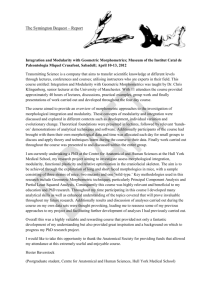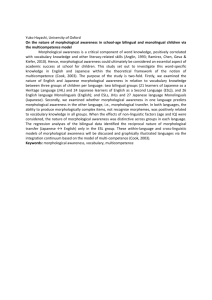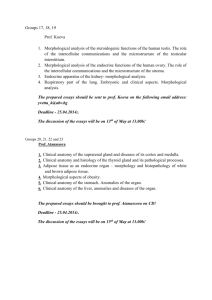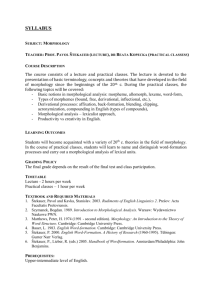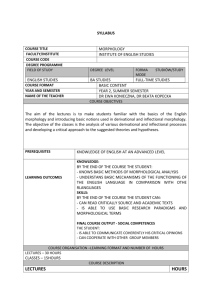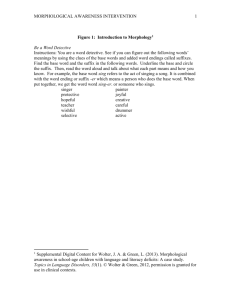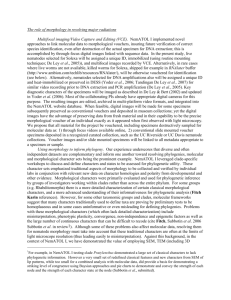Morphological modularity and the evolution of diversity
advertisement
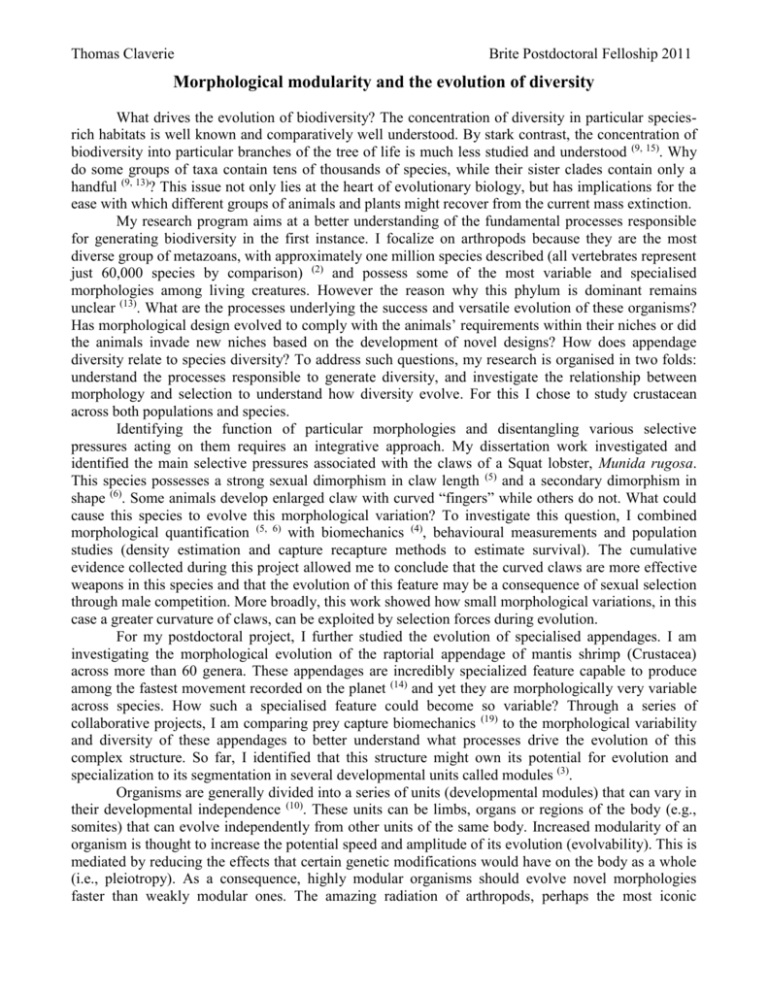
Thomas Claverie Brite Postdoctoral Felloship 2011 Morphological modularity and the evolution of diversity What drives the evolution of biodiversity? The concentration of diversity in particular speciesrich habitats is well known and comparatively well understood. By stark contrast, the concentration of biodiversity into particular branches of the tree of life is much less studied and understood (9, 15). Why do some groups of taxa contain tens of thousands of species, while their sister clades contain only a handful (9, 13)? This issue not only lies at the heart of evolutionary biology, but has implications for the ease with which different groups of animals and plants might recover from the current mass extinction. My research program aims at a better understanding of the fundamental processes responsible for generating biodiversity in the first instance. I focalize on arthropods because they are the most diverse group of metazoans, with approximately one million species described (all vertebrates represent just 60,000 species by comparison) (2) and possess some of the most variable and specialised morphologies among living creatures. However the reason why this phylum is dominant remains unclear (13). What are the processes underlying the success and versatile evolution of these organisms? Has morphological design evolved to comply with the animals’ requirements within their niches or did the animals invade new niches based on the development of novel designs? How does appendage diversity relate to species diversity? To address such questions, my research is organised in two folds: understand the processes responsible to generate diversity, and investigate the relationship between morphology and selection to understand how diversity evolve. For this I chose to study crustacean across both populations and species. Identifying the function of particular morphologies and disentangling various selective pressures acting on them requires an integrative approach. My dissertation work investigated and identified the main selective pressures associated with the claws of a Squat lobster, Munida rugosa. This species possesses a strong sexual dimorphism in claw length (5) and a secondary dimorphism in shape (6). Some animals develop enlarged claw with curved “fingers” while others do not. What could cause this species to evolve this morphological variation? To investigate this question, I combined morphological quantification (5, 6) with biomechanics (4), behavioural measurements and population studies (density estimation and capture recapture methods to estimate survival). The cumulative evidence collected during this project allowed me to conclude that the curved claws are more effective weapons in this species and that the evolution of this feature may be a consequence of sexual selection through male competition. More broadly, this work showed how small morphological variations, in this case a greater curvature of claws, can be exploited by selection forces during evolution. For my postdoctoral project, I further studied the evolution of specialised appendages. I am investigating the morphological evolution of the raptorial appendage of mantis shrimp (Crustacea) across more than 60 genera. These appendages are incredibly specialized feature capable to produce among the fastest movement recorded on the planet (14) and yet they are morphologically very variable across species. How such a specialised feature could become so variable? Through a series of collaborative projects, I am comparing prey capture biomechanics (19) to the morphological variability and diversity of these appendages to better understand what processes drive the evolution of this complex structure. So far, I identified that this structure might own its potential for evolution and specialization to its segmentation in several developmental units called modules (3). Organisms are generally divided into a series of units (developmental modules) that can vary in their developmental independence (10). These units can be limbs, organs or regions of the body (e.g., somites) that can evolve independently from other units of the same body. Increased modularity of an organism is thought to increase the potential speed and amplitude of its evolution (evolvability). This is mediated by reducing the effects that certain genetic modifications would have on the body as a whole (i.e., pleiotropy). As a consequence, highly modular organisms should evolve novel morphologies faster than weakly modular ones. The amazing radiation of arthropods, perhaps the most iconic Thomas Claverie Brite Postdoctoral Felloship 2011 segmented organisms, is hypothesised to have arisen from precisely this mechanism (1, 18). However, the hypothesis remains to be tested. My research programme at the Biodiversity Research Center would investigate whether differences in the level of modularity (the amount of independence between modules) in arthropods could affect their evolvability, measured using the proxy of morphological disparity. To do this, I will quantify and compare the evolutionary history of modularity in two sister clades of crustaceans (the Brachyura and Anomura). These two groups have strikingly different levels of morphological diversity (7) . However, they are probably affected by similar gross selective pressures since they are sympatric, with members of the two clades in close physical proximity and occupying remarkably similar niches (8, 16) . Detailed morphological measurements of animals will be used to quantify morphological variation. These data will then be analysed by an established suite of methods to test and quantify modularity (10). The evolutionary history of modularity will subsequently be reconstructed on the latest available phylogeny using maximum likelihood methods. Rates of molecular evolution, which is directly related to speed of evolution, will also be investigated in the two clades using fossil dated molecular phylogenies. It is likely, however, that molecular rates will not differ between the two clades, since no significant difference in branch lengths have been observed in any published phylogenies (12, 17). Finally, morphological disparity in the two clades will be quantified using a broad and intensive sampling of species intended to capture the full extent of their morphological variation. Using state of the art statistical tools, morphological diversity will then be compared with the evolutionary history of modularity and estimates of rate of molecular evolution. This multidisciplinary approach will allow me to test the central question: can modularity enhance evolvability and thereby promote the evolution of diversity? This project would be hosted in the Leander lab. The thematic of the proposed research largely overlap with the thematic of this lab which focus on understanding the evolution of morphological diversity in marine organisms. Furthermore after some discussion with Professor Leander, it occurred that another model organism, for which he is a specialist, could also be investigated in the same project. Some unicellular eukaryotes such as Euglenozoa posses some of the most complex morphologies seen in cells (11). Similarly to the previously proposed crustacean groups, two sister clades of Euglenozoa – Euglenids and Kinetoplastids – are ideally suited to represent a uni-cellular model system. These two clades are different in their morphological disparity and several molecular phylogenies are available (11) . Although, little is known relative to the modular organisation in single cell organisms, the repeated pattern of Euglenid cells ornamentation (pellicle) for example, could highlight an underlying modular organisation. Furthermore, the large variation in morphological patterns and diversity in eukaryotes make them another ideal system to address the previously formulated questions. Finally investigating such questions in parallel for organisms as different as unicellular and multicellular living creatures offers the opportunity to tackle mechanisms of diversification broadly relevant for any life forms. The Biodiversity Research Center would be an ideal host for this project and would provide me with fantastic opportunities to improve my academic profile. First this center regroup a large number of expert investigating biodiversity related issues using various method such as comparative methods which are of great importance in my proposed research. Secondly, this center offers great opportunities to interact with the scientific and non-scientific community and get involved in the education of undergraduate and graduate student which are two components of fundamental importance in academia. 1. Browne, W.E. and N.H. Patel, 2000. Semin. Cell Dev. Biol., 11: 427-435. 2. Chapman, A.D., 2009. 2nd ed. Canberra, Australia. 81. 3. Claverie, T., et al., 2010. Evolution. 4. Claverie, T. and I.P. Smith, 2007. Proc. R. Soc. Lond. B, 274: 3033-3038. 5. Claverie, T. and I.P. Smith, 2009. J. Mar. Biol. Assoc. U.K., 89: 1189-1194. Thomas Claverie Brite Postdoctoral Felloship 2011 6. Claverie, T. and I.P. Smith, 2010. Aquat Biol, 8: 179-187. 7. De Grave, S., et al., 2009. Raffles Bull. Zool., Supplement 21: 1-109. 8. Gorny, M., 1999. Sci. Mar., 63: 367-382. 9. Hendry, A.P., 2009. Nature, 458: 162-164. 10. Klingenberg, C.P., 2008. Annu. Rev. Ecol. Evol. Syst., 39: 115-132. 11. Leander, B.S., et al., 2007. Bioessays, 29: 987-1000. 12. Martin, J.W., et al., eds. 2009. Boca Raton, FL. 616. 13. Mayhew, P.J., 2007. Biol. Rev., 82: 425-454. 14. Patek, S.N., et al., 2004. Nature, 428: 819-820. 15. Schlichting, C.D. and C.J. Murren, 2004, Q.C.B. Cronk, et al., Editors. NRC Research Press: Ottawa. p. 166. 16. Spano, N., 1998. J. Nat. Hist., 32: 1697-1705. 17. Tsang, L.M., et al., 2008. Mol. Phylogenet. Evol., 48: 359-368. 18. Williams, T.A. and L.M. Nagy, 2001. J. Exp. Zool. Part B, 291: 241-257. 19. Zack, T.I., et al., 2009. J. Exp. Biol., 212: 4002-4009.

